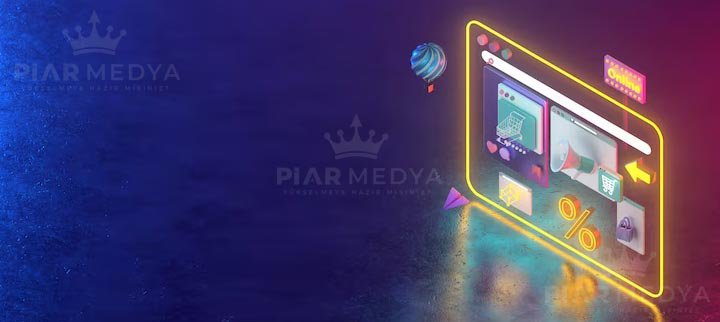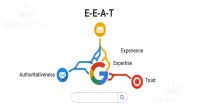What is Web Design? Why is it Important? (Beginner's Guide)
Web design refers to the process of arranging websites in a user-friendly, aesthetic, and functional manner. Take a look at the beginner's guide. You will find answers to all your questions related to topic What is Web Design? Why is it Important? (Beginner's Guide) in the continuation of the text.

What is a Website and How Does It Work?
What is Web Design?
What are the Importance and Advantages of Web Design?
What are the Fundamental Elements of Web Design?
Website Design Processes
Relationship Between SEO and Web Design
Mobile Compatibility and Web Design
Security in Web Design
What Should a Quality Website Look Like?
In Summary
Web design, is the art and science of organizing websites on the internet to be more accessible and user-friendly. A good website not only aims to be aesthetically pleasing but also aims to enhance user experience, boosting interaction with the target audience and increasing conversions. In the continuation of the text, we will provide comprehensive information about web design, starting with its basic concepts.
What is a Website and How Does It Work?
A website is a digital platform on the internet where accessible and viewable content is located. It can host various types of content such as text, images, videos, audio files, and interactive elements. Websites can be used for presenting information, entertainment, commerce, communication, and many other purposes. To understand how a website works, its primary components and operations can be listed as follows:
- Server and Hosting
- Domain Name
- Browsers
- Client and Server Communication
- HTML, CSS ve JavaScript
- Web Server Software
- Database and Dynamic Content
- Security and SSL Certificates
The basic functioning of a website is as follows: Users enter the domain name using their browsers and access the website. The server receives the request, prepares the content, and sends it back to the browser. Users then view and interact with the web pages.
What is Web Design?
Web design, refers to the process that ensures websites are user-friendly, aesthetic, and functional. The process encompasses efforts to improve user experience while simultaneously ensuring that the site is designed in accordance with its purpose. Web design is at the intersection of disciplines such as graphic design, user experience design (UI/UX), software development, and information architecture.
History of Web Design
The origins of web design date back to the 1990s. The earliest websites were simple structures that were text-based and had limited graphics. However, as the popularity of the internet increased, the field of web design began to evolve rapidly. With the 2000s, significant advancements were made in web design using CSS and more advanced versions of HTML.
What are the Importance and Advantages of Web Design?
Web design is a critical factor determining whether a website will be successful. Internet users show more interest in websites that are visually appealing and user-friendly. Users do not want to waste time on a difficult or complicated site; they want to quickly access the information they are looking for. Thus, effective web design improves the user experience, prompting visitors to spend more time on the site and increasing conversion rates. Here are the importance and advantages of web design:
- First Impression: Your website's design forms the first impression for your visitors. A well-designed website creates a sense of trust, professionalism, and quality, while a poor design can cause visitors to abandon you.
- User Experience: Good web design allows your visitors to easily navigate your site and find what they are looking for. A user-friendly design increases visitor satisfaction and raises conversion rates.
- Brand Identity: Your website reflects your brand's digital identity. A website designed in line with your brand increases your brand value and sets you apart from your competitors.
- SEO Compatibility: Good web design should be compatible with search engine optimization (SEO). Proper structure, use of tags, and fast loading times help your website rank higher in search engines.
- Mobile Compatibility: With the rise in mobile device usage, mobile-friendly web design has become increasingly important. A mobile-compatible website enhances the experience for mobile visitors and positively affects your search engine rankings.
- Competitive Advantage: A well-designed website offers an advantage over competitors. Visitors may prefer to interact more with sites offering a better user experience.
- More Customers and Revenue: Good web design increases conversion rates, leading to more customers and revenue.
- Trust and Reliability: A well-designed website instills trust in visitors and establishes a trustworthy brand image.
What are the Fundamental Elements of Web Design?
Web design relies on several essential elements through which users interact with websites. Here are the fundamental elements of web design:
- Colors: Colors are one of the primary elements determining the appearance of a website. Choosing the right colors is crucial to reflect the brand identity, influence emotional responses, and enhance the user experience.
- Typography: The right font choice makes texts easily readable and can reflect the purpose and style of the website. Different typography styles can be used for headers, text, and emphasis.
- Icons and Graphics: Icons and graphics provide enriched visual content. They can attract user attention, convey information, or encourage actions.
- Layout and Placement: The page layout and content placement affect the ease with which users navigate and access the information. Proper layout ensures users find the information they need without effort.
- Mobile Compatibility: Ensuring the website is responsive and looks and functions correctly on mobile devices is a necessity today.
- Interactive Elements: These elements, like buttons or forms, enable user interaction with the website.
- Navigation: Navigation helps users move through different sections of a website. Clear, intuitive navigation ensures users can easily find the content they seek.
- Loading Time: Users expect web pages to load quickly. Efficient design, optimized images, and code can significantly reduce loading times.
Website Design Processes
To create a website, the general steps that can be followed consist of the following points, but they can be customized based on the website's purpose, target audience, and features:
- Defining Purpose and Goals
- Identifying the Target Audience
- Choosing a Domain Name and Hosting
- Selecting a Platform
- Choosing Design and Theme
- Creating Content
- SEO Optimization (Optional)
- Forms and Contact Information
- Testing and Bug Fixing
- Publishing and Indexing
- Monitoring and Analysis
- Updating and Maintenance
Web design processes can be quite sensitive and complex. Especially when aiming to create a customized and effective website, you may need to seek professional help. A specialized web design agency can assist you in creating a design that aligns with your goals, optimizing user experience, and overcoming technical challenges. This way, you can gain the expertise and experience necessary for the successful implementation of your website.
Relationship Between SEO and Web Design
SEO (Search Engine Optimization) involves a series of technical and strategic efforts aimed at improving a website's ranking and visibility on search engines. There is a strong relationship between web design and SEO because good web design can impact SEO performance, and likewise, a solid SEO strategy can influence web design. Here are some important points about the relationship between SEO and web design:
- Site Speed: The fast loading of a website is crucial for both user experience and SEO. Search engines prefer fast-loading sites, which reduces the likelihood of users leaving the site. Optimized images, efficient coding, and reduced file sizes in web design provide a significant advantage for improving site speed.
- Mobile Compatibility: A mobile-friendly and user-friendly web design enhances user satisfaction and encourages search engines like Google to prefer mobile-responsive sites. Non-mobile-friendly sites might have a disadvantage in SEO rankings.
- Clean Code: The code structure of a website should be clean, organized, and semantic. Search engines can better scan and index well-coded sites. Clean code also positively affects page loading and performance.
- Solving Website Errors: Addressing and solving errors on a website are critical steps in enhancing user experience and maintaining site reliability. Identifying and fixing broken links, 404 errors, slow page loading times, and browser compatibility issues are essential. Regularly testing the website and promptly rectifying errors not only increase user satisfaction but also secure the website's credibility. Effectively solving these issues elevates users' trust in the website, boosts SEO performance, and ensures a superior user experience.
- URL Structure: The URL structure of a website should be clear for both users and search engines. SEO-friendly URLs should reflect keywords and content clearly.
- Content Management: Website content should be valuable for users and indexable by search engines. Proper use of header tags, meta descriptions, and content optimization are essential for SEO.
- Links: Internal and external links on a website are important for improving user experience and SEO performance. Internal links connect content, allowing users to access more information, while external links can lead to reliable and authoritative sources.
- Site Map: A site map displays the hierarchical structure of a website's pages and guides search engines in understanding the site better. A well-structured site map can facilitate the indexing process.
- Image Optimization: Optimizing images used on a website increases page loading speed and positively impacts SEO performance. Proper image sizes and optimized file formats are crucial for this optimization.
Mobile Compatibility and Web Design
Mobile compatibility is a critical aspect of web design, becoming essential due to the increased usage of mobile devices today. Mobile-responsive web design aims to ensure that websites are seamlessly viewed and used on different mobile devices (smartphones, tablets). Here are some key points explaining the relationship between mobile compatibility and web design:
- Varying Screen Sizes and Resolutions: Mobile devices come with various screen sizes and resolutions. Mobile-responsive web design takes this diversity into account to ensure proper display across all screen sizes.
- Touch Interaction: Mobile devices commonly utilize touch screens. As a result, mobile-responsive design incorporates special adjustments for intuitive and easy touch interactions.
- Speed and Performance: Considering that mobile devices often have slower internet connections, mobile-responsive design focuses on factors such as fast loading times and optimized images to enhance website speed.
- Navigation and Menus: Sites designed for mobile devices should feature easy-to-understand and user-friendly navigations. Typically, menus on mobile devices are presented in a simplified manner, often as dropdown menus.
- Responsive Design: Responsive web design is an approach that automatically adapts a site's layout and content based on the screen size and device. This allows the same website to work smoothly across different devices.
- SEO Alignment: Mobile-responsive web design is also important for search engine optimization (SEO). Search engines prioritize mobile-friendly sites, resulting in higher rankings.
- Mobile Compatibility Testing: After designing a mobile-responsive website, it's crucial to test it on various mobile devices. Testing across different devices and browsers is essential for optimizing user experience.
- Accelerated Mobile Pages (AMP): AMP is a technology used to accelerate web page loading. It provides faster loading times on mobile devices, enhancing user experience.
Security in Web Design
Security in web design is of great importance for safeguarding user information and data on online platforms. It also builds user trust, maintains reputation, and prevents legal issues.
It aims to reflect a website's brand identity, instill trust in visitors, and help the business achieve its goals. Here are some important considerations and the significance of security in web design:
- SSL Certificates: SSL (Secure Socket Layer) certificates enable encrypted data transmission. They indicate that user-entered information is secure and inaccessible to third parties.
- Strong Authentication: Websites can offer strong and multi-factor authentication methods for users to verify their identities.
- Up-to-Date Software and Security Patches: Website platforms and plugins should be regularly updated, and security patches applied. This ensures potential security vulnerabilities are addressed.
- Data Privacy: Protecting users' personal data is a crucial part of maintaining privacy. Data collection and processing processes should be transparent and compliant with regulations.
- Protection Against Malware: Websites should implement measures to protect against malicious software. Security firewalls and antivirus software can create a defense against attacks.
- SQL Injection and XSS Protection: Web design should incorporate measures to guard against common attacks like SQL injection and Cross-Site Scripting (XSS).
- Secure Payment Methods: Payment methods used on e-commerce sites must be secure. Protection of sensitive data like credit card information is a top priority.
- Data Backup: Regularly backing up the website helps safeguard against potential data loss.
- Secure Transaction Processes: Transactions conducted on the site (e.g., account creation, login, payment) should be managed securely.
- Defense Against Hackers: Websites can provide security services that require expertise to identify vulnerabilities and take measures against hacker attacks.
- Security Policies and User Agreements: Users should understand the website's security policies and user agreements. These documents provide information about data processing and security processes.
What Should a Quality Website Look Like?
Any website project should be customized according to the needs of your target audience and the goals of your business, but in general, expectations from a good website include the following:
User-Friendly Interface:
- Clean and organized design
- Easy navigation and menus
- Fast loading times
Responsiveness (Responsive Design):
- Providing a good appearance and usability on different devices and screen sizes
Fast Loading Times:
- Optimized images and files
- Using a good hosting provider
Security:
- Encrypted connections with SSL certificates
- Firewalls and other security measures
Mobile-Friendly Experience:
- Good visibility and usability on mobile devices
Social Media Integration:
- Sharing buttons and social media links
Contact Options:
- Accessible contact information or contact form
Analytics and Tracking:
- Integration of analytic tools to monitor visitor statistics and site performance
Accessibility:
- Design and accessibility measures for users with disabilities
Robust Search Capabilities:
- Comprehensive search functionality and quickly findable search results
User Feedback:
- Mechanisms for gathering user opinions and feedback
Ease of Updating:
- Admin panel for easily adding and editing content
Copyright and Legal Notices:
- Inclusion of necessary elements like copyright notice, privacy policy, and legal disclaimers
Cross-Browser Compatibility:
- Functioning well in different browsers (Chrome, Firefox, Safari, etc.) and operating systems
Impressive Graphics and Visuals:
- Professional images, videos, and graphics
Descriptive Headings and Title Tags:
- Increasing content comprehensibility through page titles and heading tags
Social Proof and References:
- Showcasing customer reviews, references, or previous works
Quick Communication Channels:
- Fast communication options like live chat, email, or phone
Blog or News Section:
- An area where relevant content is regularly shared
Search Engine-Friendly SEO URLs:
- Using meaningful and concise URL structures
In Summary
Web design is the process of creating the visual and functional layout of websites accessible on the internet. It aims to reflect the brand identity of a website, instill trust in visitors, and assist businesses in achieving their goals. Effective website design empowers businesses to strengthen their digital presence and enhance their online success. It positively impacts factors such as user experience, brand perception, and conversion rates, thus providing businesses with a competitive edge in the digital world.
FREQUENTLY ASKED QUESTIONS (FAQs)
When creating web design, it's important to pay attention to the following factors:
- Creating a design where users can navigate easily and find what they're looking for.
- Ensuring a design that looks good on different devices and screen sizes.
- Optimizing loading times and performance for a fast user experience.
- Ensuring the web design aligns with the corporate identity and brand value.
- Using SEO-friendly coding and content structures for better search engine rankings.
- Content Quality: Providing accurate, up-to-date, and engaging content.
- Incorporating design and security measures that adhere to security protocols.
- Designing for accessibility and implementing measures for users with disabilities.
- Providing mechanisms for users to easily communicate and engage.
Web design can be used to create a variety of things, including:
- Corporate websites
- Personal blogs
- E-commerce websites
- Portfolio websites
- News portals
- Educational platforms
- Reservation systems
- Social media platforms
Web design and graphic design share similar elements, but they are distinct from each other. Graphic design is typically used for designing printed materials such as brochures, posters, logos, book covers, etc. On the other hand, web design specifically involves designing websites that are accessible on the internet. Web design considers user experience and interaction, while graphic design tends to be more static and one-dimensional.
Web design and graphic design share similar elements, but they are distinct from each other. Graphic design is typically used for designing printed materials such as brochures, posters, logos, book covers, etc. On the other hand, web design specifically involves designing websites that are accessible on the internet. Web design considers user experience and interaction, while graphic design tends to be more static and one-dimensional.
Common programs and tools used in the creation of web design include:
- Adobe XD
- Figma
- Sketch
- Adobe Photoshop
- Adobe Illustrator
- HTML and CSS code editors (Visual Studio Code, Sublime Text, etc.)
Web design is the process of creating the appearance and usability of web pages that are accessible over the internet. The process aims to create visually appealing, user-friendly, and functional websites.
Web design encompasses a range of elements, from color selection to layout, graphics to text arrangement, ensuring that websites are designed in alignment with their brand identity, user experience, and intended purposes.






